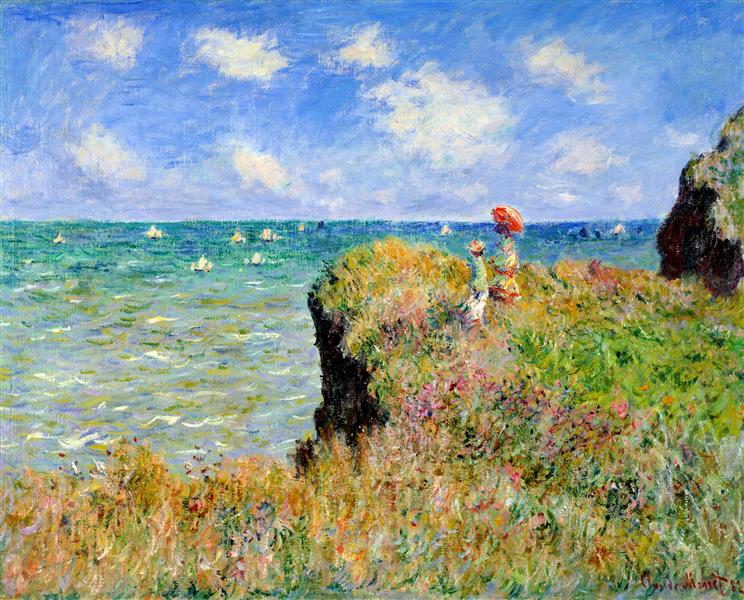תיאור
Claude Monet's painting "Walk along the Cliff at Pourville", created in 1882, is a brilliant example of the Impressionist master's approach to light and color, as well as his ability to capture the essence of an ephemeral moment in nature. In this work, Monet transports us to a coastal landscape in the Normandy region, where the formidable features of the cliffs that slope down to the sea can be appreciated. This painting evokes a sense of freedom and tranquility, typical of Monet's style, who often sought to depict the interaction of natural light with his surroundings.
The composition of the work is notable for its balance and the way it guides the viewer’s gaze. Two female figures, dressed in period costumes, walk along the spur of land that rises above the cliff. The position of these figures, which are situated to the left of the painting, creates a dynamic contrast with the vast expanse of ocean that unfolds to the right. This arrangement not only creates a sense of depth in the work, but also establishes a visual dialogue between the human and the natural.
Monet is known for his exploration of the use of color and the treatment of light, and this painting is no exception. The skies are rendered in soft shades of blue and white, barely nuanced by brushstrokes that suggest ethereal clouds floating above the scene. The cliffs, on the other hand, are depicted with a more earthy palette that includes shades of gray and beige, which contrast effectively with the vivid blue of the sea. This interplay of colors produces an almost dreamlike atmosphere, where the nuances of light give a sense of movement, as if the wind were caressing the landscape.
Furthermore, Monet captures the essence of the landscape in its purest form; elements of vegetation are suggested rather than defined, drawing the viewer's attention to the overall visual experience rather than focusing on minute details. This aspect of the Impressionist style is crucial, as it implies an emotional rather than a descriptive approach.
The use of loose, rapid brushstrokes is another significant aspect seen in "Walk on the Cliff at Pourville." Monet employs this technique to create textures that not only suggest the reality of the landscape, but also allow the light to be reflected and reinterpreted, giving the work a vibrant freshness. Each brushstroke contributes to the feeling of immediacy and presence, as if the viewer could feel the sea breeze and hear the murmur of the waves.
It is interesting to note that this painting was part of a period in Monet’s life when he was seeking to depict his immediate surroundings, moving away from more complex subject matter and focusing his attention on everyday outdoor experiences. During this time, Monet produced several works in Pourville, capturing different times of day and different light conditions, all of them characterised by this deep connection with nature and its ephemeral state.
"Walk on the Cliff at Pourville" thus stands not only as a depiction of a specific place, but as a meditation on the simple beauty of moments shared in nature, highlighting Monet's love of light and atmosphere. His ability to synthesize such experiences into painterly forms remains a lasting legacy in the history of art and the nature of Impressionism.
KUADROS ©, a famous painting on your wall.
Hand-made oil painting reproductions, with the quality of professional artists and the distinctive seal of KUADROS ©.
Painting reproduction service with satisfaction guarantee. If you are not completely satisfied with the replica of your painting, we will refund 100% of your money.

